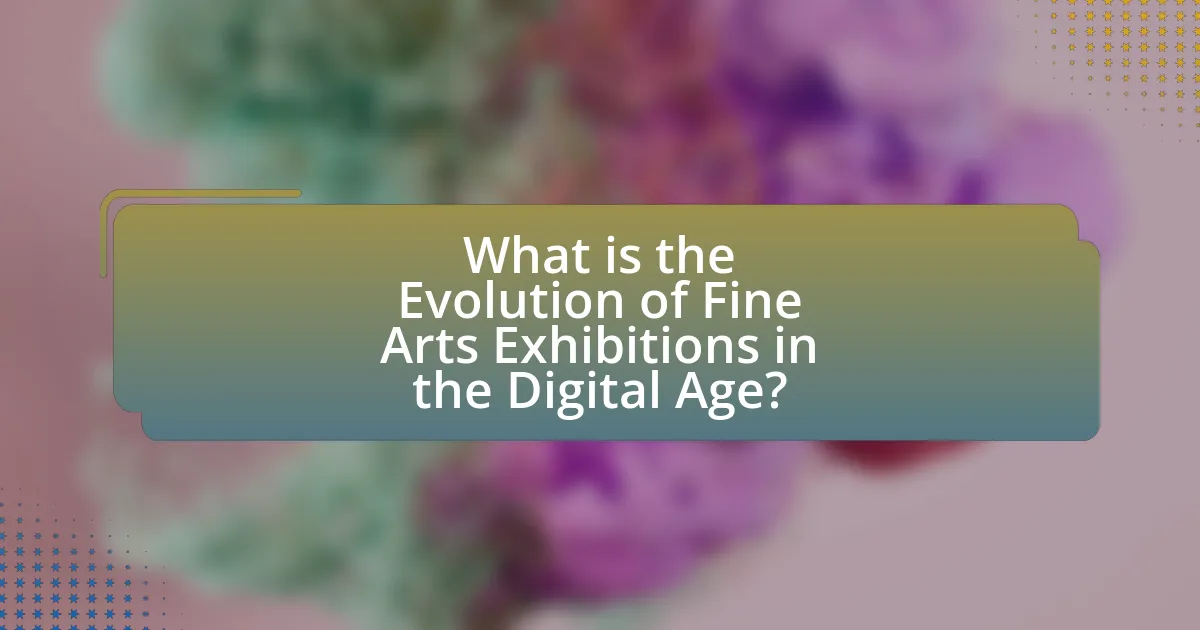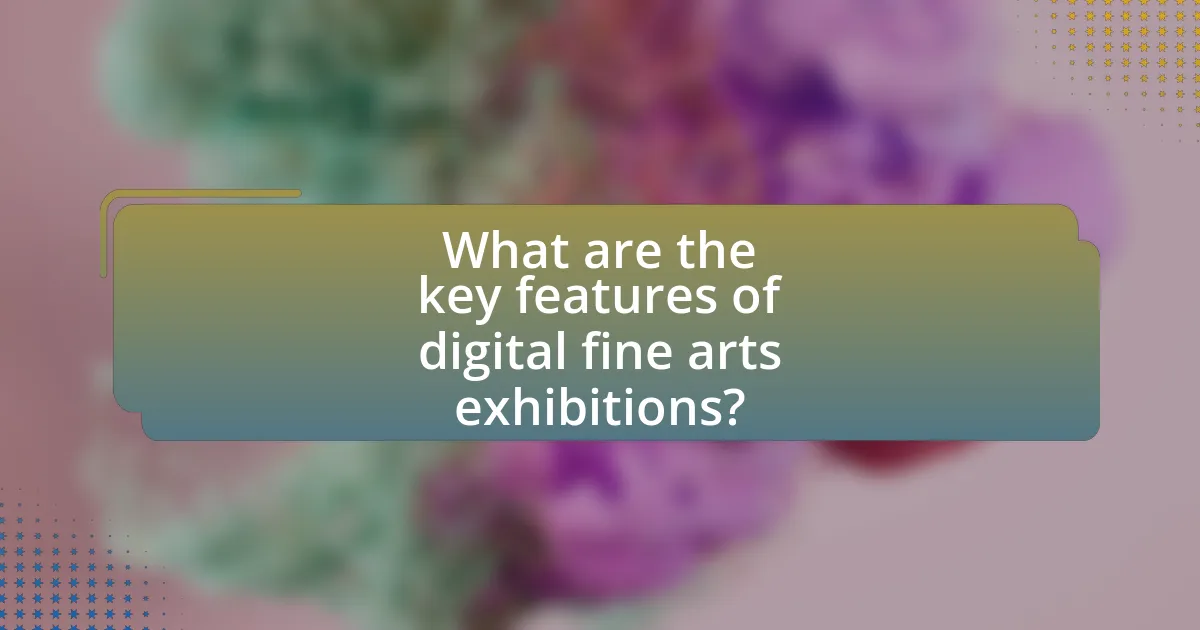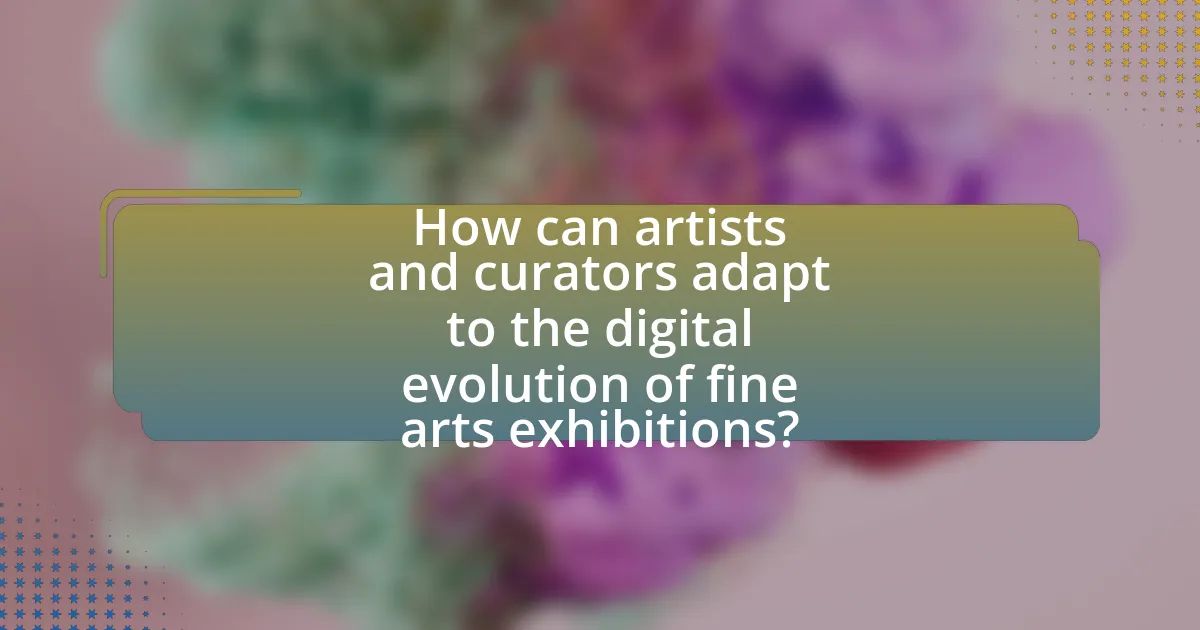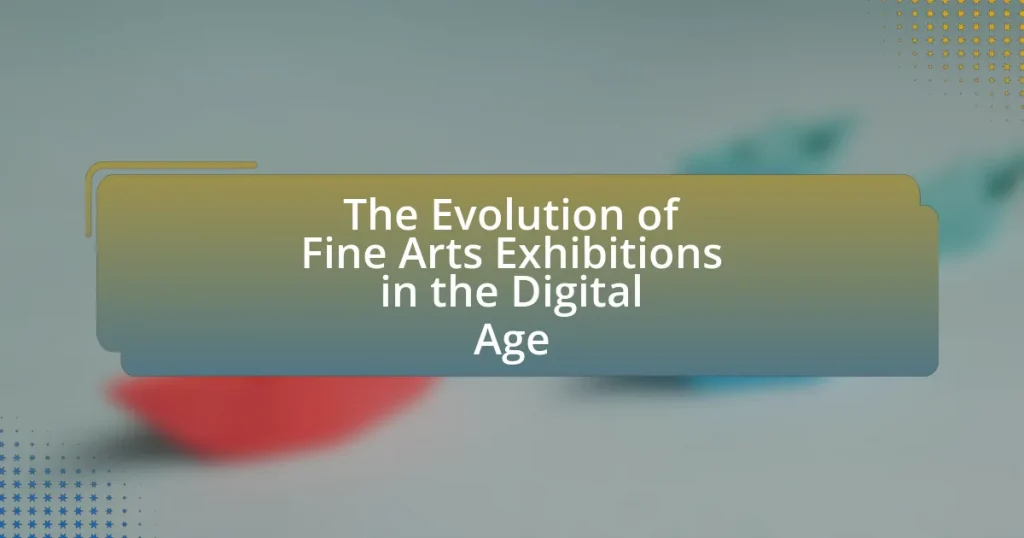The article examines the evolution of fine arts exhibitions in the digital age, highlighting the integration of digital technologies such as virtual reality, augmented reality, and online platforms. It discusses how traditional exhibitions have adapted to these advancements, enhancing accessibility and audience engagement while facing challenges from digital alternatives. Key features of digital exhibitions, including interactivity and immersive experiences, are explored, along with the role of social media in promoting art. The article also outlines strategies for artists and curators to effectively navigate this digital landscape, ensuring successful and engaging exhibitions.

What is the Evolution of Fine Arts Exhibitions in the Digital Age?
The evolution of fine arts exhibitions in the digital age has transformed how art is displayed, accessed, and experienced. Traditional physical exhibitions have increasingly integrated digital technologies, allowing for virtual galleries and online platforms that reach a global audience. For instance, during the COVID-19 pandemic, many museums and galleries shifted to virtual tours and online exhibitions, exemplified by the Louvre’s virtual experience, which attracted millions of viewers worldwide. This shift not only democratizes access to art but also enables innovative presentation methods, such as augmented reality and interactive installations, enhancing viewer engagement. The integration of social media further amplifies this evolution, allowing artists and institutions to share their work instantly and interactively with audiences, thus reshaping the landscape of fine arts exhibitions.
How have traditional fine arts exhibitions changed with digital advancements?
Traditional fine arts exhibitions have transformed significantly due to digital advancements, primarily through the integration of virtual reality, online platforms, and digital marketing strategies. These technologies enable broader access to artworks, allowing audiences to experience exhibitions remotely, which was not possible in traditional settings. For instance, institutions like the Louvre have utilized virtual tours, attracting millions of online visitors, thereby expanding their reach beyond physical limitations. Additionally, social media platforms have become essential for promoting exhibitions, engaging audiences, and facilitating discussions around art, which enhances visibility and interaction. This shift not only democratizes access to art but also alters the way artists and curators present and market their work, reflecting a significant evolution in the fine arts landscape.
What technologies have influenced the transformation of fine arts exhibitions?
Digital technologies, including virtual reality (VR), augmented reality (AR), and interactive installations, have significantly influenced the transformation of fine arts exhibitions. These technologies enable immersive experiences, allowing visitors to engage with artworks in innovative ways. For instance, VR can transport viewers into a digital environment where they can explore art beyond physical limitations, while AR can overlay digital information onto physical artworks, enhancing understanding and interaction. Additionally, the use of social media platforms for promotion and audience engagement has reshaped how exhibitions are marketed and experienced, broadening accessibility and participation. The integration of these technologies has led to a more dynamic and participatory art experience, reflecting contemporary cultural shifts.
How has audience engagement evolved in the digital context?
Audience engagement has evolved significantly in the digital context through the integration of interactive technologies and social media platforms. Traditional methods of audience engagement, such as passive viewing in physical spaces, have transitioned to dynamic interactions where audiences can participate in real-time discussions, share experiences, and provide feedback via digital channels. For instance, studies show that virtual exhibitions have increased audience reach by over 300%, allowing institutions to engage with a global audience that was previously inaccessible. Additionally, the use of augmented reality (AR) and virtual reality (VR) in fine arts exhibitions has enhanced the immersive experience, enabling audiences to interact with artworks in innovative ways. This evolution reflects a shift towards a more participatory culture, where audience members are not just observers but active contributors to the artistic dialogue.
Why is the digital age significant for fine arts exhibitions?
The digital age is significant for fine arts exhibitions because it enhances accessibility and engagement for a global audience. Digital platforms allow museums and galleries to showcase artworks online, reaching viewers who may not be able to visit in person. For instance, the Louvre reported a 30% increase in virtual visitors during the pandemic, demonstrating the effectiveness of digital exhibitions in expanding audience reach. Additionally, technologies like augmented reality and virtual reality create immersive experiences, allowing viewers to interact with art in innovative ways. This shift not only democratizes access to art but also transforms how audiences experience and appreciate fine arts.
What challenges do traditional exhibitions face in the digital era?
Traditional exhibitions face significant challenges in the digital era, primarily due to competition from virtual platforms that offer immersive experiences. These digital alternatives allow audiences to engage with art from anywhere, reducing foot traffic to physical venues. Additionally, traditional exhibitions struggle with high operational costs, including venue rental and logistics, which can be less appealing compared to the lower expenses associated with online exhibitions. Furthermore, the shift in audience expectations towards interactive and personalized experiences complicates the ability of traditional exhibitions to attract and retain visitors. According to a report by the International Council of Museums, 70% of museums have noted a decline in physical attendance due to the rise of digital engagement options.
How does digital accessibility impact the reach of fine arts exhibitions?
Digital accessibility significantly expands the reach of fine arts exhibitions by enabling a broader audience to engage with the content. When exhibitions are designed with accessibility in mind, they can be accessed by individuals with disabilities, including those with visual, auditory, or cognitive impairments. For instance, the National Endowment for the Arts reported that accessible digital platforms can increase visitor numbers by up to 30%, as they allow people who may not be able to visit physical locations to experience the art remotely. This inclusivity not only enhances audience diversity but also fosters a more equitable cultural landscape, ensuring that fine arts are available to all, regardless of physical limitations.

What are the key features of digital fine arts exhibitions?
Digital fine arts exhibitions primarily feature interactivity, accessibility, and immersive experiences. Interactivity allows viewers to engage with artworks through digital tools, enhancing their understanding and appreciation. Accessibility ensures that a broader audience can experience art from anywhere in the world, breaking geographical barriers. Immersive experiences often utilize virtual reality or augmented reality technologies, creating a deeper emotional connection with the art. These features reflect the shift towards a more inclusive and engaging approach in the presentation of fine arts, as evidenced by the increasing number of online exhibitions and virtual galleries that have emerged, particularly during the COVID-19 pandemic, which accelerated the adoption of digital platforms in the art world.
How do virtual galleries differ from physical exhibitions?
Virtual galleries differ from physical exhibitions primarily in their accessibility and interaction capabilities. Virtual galleries allow users to explore art from anywhere in the world at any time, breaking geographical barriers that physical exhibitions impose. For instance, a study by the National Endowment for the Arts in 2021 indicated that online art platforms increased audience reach by over 50% compared to traditional galleries. Additionally, virtual galleries often incorporate interactive features such as 3D walkthroughs and augmented reality, enhancing viewer engagement in ways that physical spaces cannot replicate. This shift towards digital formats reflects the evolving landscape of art consumption in the digital age.
What are the advantages of virtual galleries for artists and curators?
Virtual galleries provide artists and curators with increased accessibility and broader audience reach. By eliminating geographical barriers, artists can showcase their work to a global audience, significantly enhancing visibility and potential sales. According to a report by Art Basel and UBS, the online art market reached $12.4 billion in 2021, indicating a growing trend towards digital platforms for art sales. Additionally, virtual galleries often have lower operational costs compared to physical spaces, allowing curators to allocate resources more efficiently. This shift also enables innovative presentation formats, such as interactive experiences and multimedia integration, which can engage viewers in new ways.
How do immersive technologies enhance the exhibition experience?
Immersive technologies enhance the exhibition experience by creating interactive and engaging environments that captivate visitors. These technologies, such as virtual reality (VR) and augmented reality (AR), allow attendees to experience art in a more profound way, facilitating deeper emotional connections and understanding. For instance, a study by the Museum of Modern Art in New York found that visitors who engaged with AR installations reported a 30% increase in their overall satisfaction and retention of information compared to traditional exhibits. This demonstrates that immersive technologies not only attract more visitors but also enrich their experience, making art more accessible and relatable.
What role do social media and online platforms play in fine arts exhibitions?
Social media and online platforms serve as crucial tools for promoting and enhancing fine arts exhibitions. They enable artists and galleries to reach wider audiences, facilitating engagement and interaction that traditional methods cannot achieve. For instance, platforms like Instagram and Facebook allow for real-time sharing of exhibition highlights, artist interviews, and behind-the-scenes content, which can significantly increase visibility and attendance. According to a study by the National Endowment for the Arts, 53% of art audiences reported discovering new exhibitions through social media, underscoring its impact on audience development. Additionally, online platforms provide opportunities for virtual exhibitions, allowing global access to artworks and fostering inclusivity in the art community.
How can artists leverage social media for exhibition promotion?
Artists can leverage social media for exhibition promotion by creating engaging content that showcases their artwork and exhibition details. By utilizing platforms like Instagram, Facebook, and Twitter, artists can reach a wider audience, as these platforms have millions of active users. For instance, a study by the Pew Research Center indicates that 69% of adults in the U.S. use social media, providing artists with a significant opportunity to connect with potential attendees.
Additionally, artists can use targeted advertising on these platforms to reach specific demographics interested in art, thereby increasing the likelihood of exhibition attendance. Engaging with followers through live streams, behind-the-scenes content, and interactive posts can also enhance audience interest and participation. Furthermore, using relevant hashtags can improve visibility and attract art enthusiasts who may not be directly connected to the artist.
What are the implications of online reviews and feedback for exhibitions?
Online reviews and feedback significantly influence exhibitions by shaping public perception and attendance. Positive reviews can enhance an exhibition’s reputation, leading to increased visitor numbers, while negative feedback can deter potential attendees. Research indicates that 84% of people trust online reviews as much as personal recommendations, highlighting their impact on decision-making. Furthermore, exhibitions that actively engage with feedback can improve visitor experience and adapt their offerings, fostering a more dynamic and responsive cultural environment. This responsiveness can lead to higher satisfaction rates and repeat visits, ultimately benefiting the exhibition’s longevity and success.

How can artists and curators adapt to the digital evolution of fine arts exhibitions?
Artists and curators can adapt to the digital evolution of fine arts exhibitions by embracing technology to enhance accessibility and engagement. This includes utilizing virtual reality and augmented reality to create immersive experiences that allow audiences to interact with artworks in innovative ways. For instance, the use of online platforms for virtual exhibitions has increased significantly, with a report from Art Basel indicating that 70% of galleries participated in online viewing rooms during the pandemic, showcasing the shift towards digital engagement. Additionally, artists and curators can leverage social media to reach broader audiences, as platforms like Instagram have become essential for promoting art and connecting with viewers. By integrating these digital tools, artists and curators can not only preserve the relevance of fine arts exhibitions but also expand their reach and impact in a rapidly evolving landscape.
What strategies can be employed to create engaging digital exhibitions?
To create engaging digital exhibitions, employing interactive elements, storytelling techniques, and user-centered design is essential. Interactive elements, such as virtual reality experiences or gamification, enhance user engagement by allowing visitors to explore content actively. Storytelling techniques, including narrative arcs and thematic organization, help to create a cohesive experience that resonates emotionally with the audience. User-centered design focuses on accessibility and usability, ensuring that the exhibition is navigable and enjoyable for diverse audiences. Research indicates that interactive and narrative-driven digital experiences significantly increase visitor retention and satisfaction, as evidenced by studies showing that 70% of users prefer interactive content over static presentations.
How can storytelling enhance the digital exhibition experience?
Storytelling enhances the digital exhibition experience by creating an emotional connection between the audience and the artwork. This connection is achieved through narrative techniques that provide context, background, and meaning to the pieces displayed. For instance, a digital exhibition that incorporates stories about the artists, the historical significance of the works, or the cultural context can engage viewers more deeply, making the experience memorable and impactful. Research indicates that storytelling can increase retention of information by up to 65%, demonstrating its effectiveness in enhancing audience engagement and understanding in digital formats.
What tools are available for curating digital exhibitions effectively?
Tools available for curating digital exhibitions effectively include platforms like Artsteps, Omeka, and Curat10n. Artsteps allows users to create 3D virtual exhibitions, providing an immersive experience for viewers. Omeka is a web-publishing platform designed for sharing digital collections and exhibits, enabling curators to organize and present their materials effectively. Curat10n offers a user-friendly interface for creating online exhibitions, focusing on storytelling and audience engagement. These tools enhance the curation process by facilitating the organization, presentation, and accessibility of digital art collections.
What best practices should be followed for successful digital fine arts exhibitions?
Successful digital fine arts exhibitions should prioritize user engagement, high-quality visuals, and effective marketing strategies. Engaging users through interactive elements, such as virtual tours and artist interviews, enhances the viewer experience and fosters a deeper connection with the artwork. High-quality visuals are essential; using high-resolution images and videos ensures that the art is presented in its best form, which is crucial for attracting and retaining audience attention. Effective marketing strategies, including social media promotion and email campaigns, are vital for reaching a broader audience and driving attendance. According to a study by the National Endowment for the Arts, digital engagement can significantly increase audience reach, demonstrating the importance of these best practices in achieving successful outcomes in digital fine arts exhibitions.
How can artists ensure their work is showcased effectively online?
Artists can ensure their work is showcased effectively online by utilizing high-quality images and engaging descriptions on platforms designed for art display. High-resolution images attract viewers and allow for detailed examination of the artwork, while compelling descriptions provide context and emotional connection, enhancing viewer engagement. Research indicates that listings with professional images and thorough descriptions receive 94% more views compared to those without (Artfinder, 2021). Additionally, leveraging social media platforms and art-specific websites increases visibility and reach, allowing artists to connect with a broader audience and potential buyers.
What common pitfalls should be avoided in digital exhibitions?
Common pitfalls to avoid in digital exhibitions include poor user experience, lack of interactivity, and inadequate promotion. Poor user experience can lead to high bounce rates; for instance, a study by Nielsen Norman Group found that 94% of first impressions relate to design. Lack of interactivity diminishes engagement; research indicates that interactive elements can increase visitor retention by up to 50%. Inadequate promotion results in low visibility; according to a report by HubSpot, 70% of marketers say that content marketing increases engagement, yet many digital exhibitions fail to leverage this effectively.














